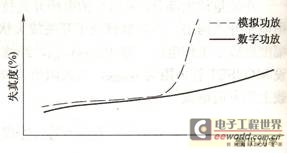Ⅰ、The difference between digital power amplifier and Class D power amplifier
The working principle of common class D power amplifier (PWM power amplifier) : PWM power amplifier can only accept analog audio signals, and the triangle wave generated by the internal triangle wave generator is compared with it, the result is a pulse width modulation signal (PWM), and then the PWM signal is amplified and restored to analog audio signals. Therefore, the PWM power amplifier is used to simulate the analog audio amplitude with the pulse width, and the information transmission process is analog, non-quantized, and non-code. And due to the limitations of the current device performance, PWM power amplifier can not use too high sampling frequency, the performance index is still not up to the level of Hi-Fi level. The digital power amplifier uses some pulses with fixed width to digitally quantify and encode the analog audio signal, so that the restoration of the audio signal is more real.
Ⅱ、The difference between digital and analog power amplifiers
Because the working mode of digital power amplifier is completely different from that of traditional analog power amplifier, it overcomes some inherent shortcomings of analog power amplifier and has some unique characteristics.
1. Overload capacity and power reserve
The overload capacity of digital power amplifier circuit is much higher than that of analog power amplifier. The analog power amplifier circuit is divided into class A, Class B or class AB power amplifier circuit, and the power amplifier tube works in the linear region during normal operation; When the overload, the power amplifier works in the saturated area, harmonic distortion occurs, the degree of distortion increases exponentially, and the sound quality deteriorates rapidly. While the digital power amplifier has been in the saturation region and the cut-off region when the power amplifier is amplified, as long as the amplifier tube is not damaged, the distortion will not increase rapidly, as shown in Figure 1.

Because the digital power amplifier uses a switching amplifier circuit, the efficiency is extremely high, up to 75%~90% (the analog power amplifier efficiency is only 30%~50%), and there is basically no heat at work. Therefore, it does not simulate the static current consumption of power amplifier, all energy is almost reserved for audio output, coupled with no analog amplification before and after, no negative feedback check, so it has better "power" characteristics, transient response is good, "explosion sense" is very strong.
2. Crossover distortion and mismatch distortionAnalog Class B power amplifier in zero-cross distortion, which is due to the nonlinear characteristics of the transistor in the small current caused by the distortion at the positive and negative intersection of the output waveform (small signal transistor will work in the cut-off zone, no current through, resulting in serious distortion of the output). The digital power amplifier only works in the switching state and does not produce crossover distortion. {{page}}
The analog power amplifier has the mismatch distortion of the output waveform caused by the inconsistent characteristics of the push-pull pair tube, so the requirements of the power amplifier tube are very strict when designing the push-pull amplifier circuit. The digital power amplifier has no special requirements for the pairing of the switch tube, and basically does not require strict selection to be used.
3. Power amplifier and speaker matching
Due to the large internal resistance of the amplifier tube in the analog power amplifier, the working state of the analog power amplifier circuit will be affected by the size of the load (speaker) when matching speakers with different resistance values. The internal resistance of the digital power amplifier does not exceed 0.2Ω(the internal resistance of the switch tube plus the internal resistance of the filter), and the resistance value (4~8Ω) relative to the load (speaker) is completely negligible, so there is no matching problem with the speaker.
4. Transient intermodulation distortion
Almost all the analog power amplifier uses negative feedback circuit to ensure its electroacoustic index, in the negative feedback circuit, in order to suppress parasitic oscillation, the phase compensation circuit is used, which will produce transient intermodulation distortion. Digital amplifiers do not use any analog amplification feedback circuit in power conversion, thus avoiding transient intermodulation distortion.
5. Sound image location
For analog amplifiers, there is generally a phase difference between the output signal and the input signal, and the phase distortion is different when the output power is different. The digital power amplifier uses digital signal amplification, so that the phase of the output signal and the input signal are completely consistent, and the phase shift is zero, so the sound and image positioning is accurate.
6. upgrade
Digital power amplifiers can gain high power by simply replacing the switching amplifier module. The high power switch amplifier module has low cost and broad development prospect in the professional field.
7. Production debugging
The analog power amplifier has the debugging problem of various working points, which is not conducive to mass production. Most of the digital amplifiers are digital circuits, which generally can work normally without debugging, and are especially suitable for large-scale production.Ⅲ、The difference between digital power amplifier and "digital" power amplifier and "digital" power amplifier
The so-called "digital" power amplifier only uses the digital signal processing method on the prestage, after the analog audio signal or digital audio signal input, the existing digital audio processing integrated circuit is used to achieve some functions such as sound field processing, digital delay, reverberation and so on, and finally audio amplification through the analog power amplifier module. The typical circuit block diagram is shown in Figure 2. As can be seen from Figure 2, the interfaces of each module are simulated. The general principle block diagram of the digital sound field processing module is shown in Figure 3. {{page}}

图2 数字化功放电路的组成框图

In addition to the interface for the speaker (this is because the speaker can only accept analog audio signals), the audio signal is processed in the way of digital signals inside the amplifier (including power amplification); For analog audio signals, they must be converted into digital signals before they can be processed.
The introduction of digital amplifiers in an era where digital audio is already available will likely have a significant impact on the development of audio technology.
免责声明: 本文章转自其它平台,并不代表本站观点及立场。若有侵权或异议,请联系我们删除。谢谢! Disclaimer: This article is reproduced from other platforms and does not represent the views or positions of this website. If there is any infringement or objection, please contact us to delete it. thank you! |


